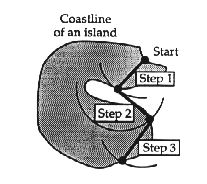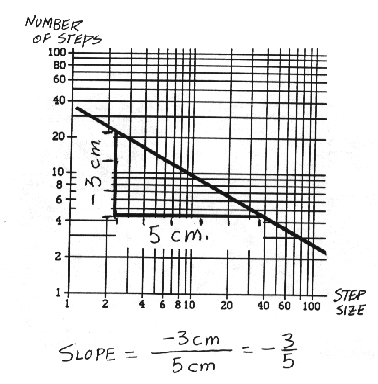
Activity 1: ``Walking'' Along a Coastline
Stepping Along a Coastline with a Caliper
To investigate coastlines, start by ``walking'' along the map of a
coastline (see Figure 1).

- 1. Obtain the following:
- [A.] a map of the coastline to be measured.
- [B.] a pair of calipers (dividers). A caliper or divider is like a
circle-drawing compass, except that both ends have points.
- [C.] this table.
| 1. Size of step, S | 2. Predicted Number of Steps,
N | 3. Measured Number of Steps, N | 4. "Length"= N*S |
|
|
|
|
|---|
|
|
|
|
|---|
|
|
|
|
|---|
|
|
|
|
|---|
|
|
|
|
|---|
|
|
|
|
|---|
- [2.] Make decisions about:
- [A.] the points on the map between which to measure the length of coastline
- [B.] the scaled distance on the map for the first setting between the
ends of the calipers (preferably a multiple of two, such as 64 kilometers
or 32 miles).
- [3.] Separate the points of the calipers by the scaled distance of
step 2B. Place the first end of the calipers at the beginning of the
coastline to be measured and swing your calipers so that the second end
rests on the coastline as close to the starting point as possible. This
is step number 1.
- [4.] Now swing the caliper so that the first end ``walks'' along to the
nearest next point on the coastline. This is step number 2.
- [5.] Continue this process, counting the steps as you go; stop when your
next step would carry you beyond the end of the coastline. The total
number of steps multiplied by the distance covered in each step gives an
initial measurement of the length of your coastline. For example: 10
steps, each of a scaled length of 64 kilometers, yields a total length of
10 * 64 kilometers = 640 kilometers.
- [6.] Enter the size of the step (in miles, kilometers, or
whatever) in the left column of your copy of Table 1 (above). Enter
the number of steps in the third column.
- [7.] Now you are going to start again, this time reducing the
distance between the calipers to half its original value. Before you do
this, predict the number of steps it will take you to walk along
the coastline with this smaller step size. Enter your prediction in the
second column of your copy of the table.
- [8.] ``Walk'' along the coastline with the calipers set to half the
original distance. This is equivalent to a child (instead of an adult)
walking a shoreline. Count the total number of steps and record the
results in the correct columns of your copy of Table 1. How accurate
was your predicted number of steps?
- [9.] Repeat the process of cutting in half the distance between
the caliper points as many times as you can, each time making a
prediction, taking the walk, and filling in your copy of the table with
your results.
- [10.] Fill in the right-hand column of your copy of the table by
multiplying each step size by the number of steps to get a total
``length.''
Did your prediction of the number of steps become more accurate with
each new setting of the calipers? What happens to the total length of
the coastline for different step sizes? Take a guess: What is the
``final length'' of the coastline as the step size gets smaller and
smaller?
Now you are going to plot on graph paper the data you collected from
your coastline measurements.

This is a special kind of graph paper. If you have not used such
graph paper before, the uneven scales may appear odd.
These scales, called logarithmic or ``doubling'' scales. Basically,
the numbers 1, 2, 4, 8, 16, ... occur at equal intervals along each
axis, as do the numbers 1, 10, 100, 1000, ... When logarithmic scales
are along both axes, the graph paper is called log-log paper.
For now, you need to know only one thing about this novel scale: You can
add a zero to all the numbers along either axis and the graph paper is
equally useful. For example, the vertical axis can be relabeled 10, 20,
40, ..., or 100, 200, 400, ... or 0.1, 0.2, 0.4, ... If the entries in
your copy of the table do not match the numbers on one axis of the graph
paper, just multiply all the numbers on that axis by 10 or by 1/10 until
they do match.
- 1.
- Plot the numbers from your table on a copy of the graph paper.
Plot the number of steps along the vertical axis and the step size
along the horizontal axis. What kind of curve do the plotted points
form? Do they lie along a straight line? When they lie along a straight
line on this kind of graph, it is possible to define the object's
dimension. The dimension is equal to the magnitude of the slope
of this straight line. For some objects this slope---this dimension---is
not a whole number. Objects with non-integer dimension are called
fractals (meaning they have ``fractional'' dimensions).
- 2.
- With a ruler, draw by eye the ``best'' straight line using
the points on your graph. Determine the magnitude of the slope of your
graph. The slope is defined as the change in vertical rise along the
line divided by the change in horizontal run along the line (or "rise"
over "run").
These vertical and horizontal changes are laid out using linear
measures, not logarithmic. Use a regular ruler to measure this slope,
not the scale along the axes. What is the magnitude of the
slope (the dimension) of your coastline?

| d | Number of Segments of length d needed to span line of
length L=100 | Number of squares of side d needed to cover square
of area L2=10000
| Number of cubes of edge d needed to fill cube of volume
L3=106 |
|---|
| 1 |
|
|
|
|---|
| 2 |
|
|
|
|---|
| 5 |
|
|
|
|---|
| 10 |
|
|
|
|---|
| 20 |
|
|
|
|---|
| 50 |
|
|
|
|---|
| 100 |
|
|
|
|---|
Return to: Coastline Page
|

